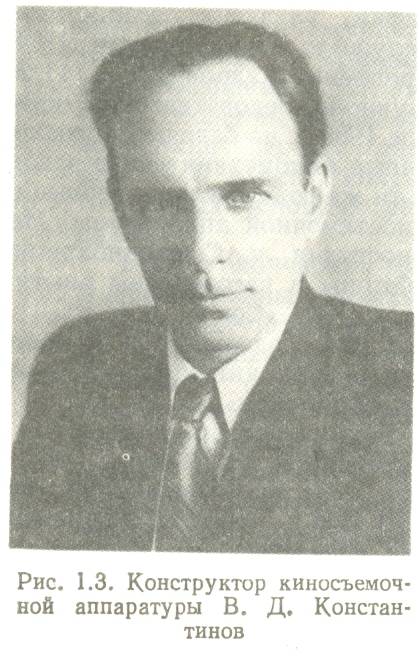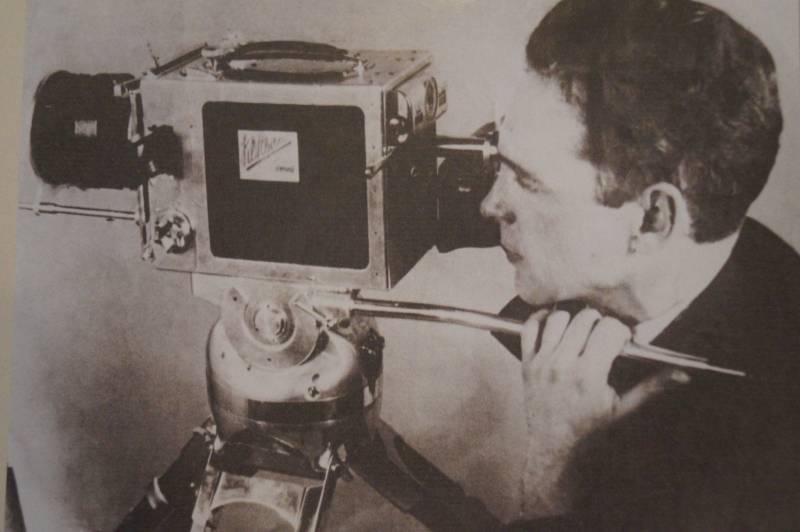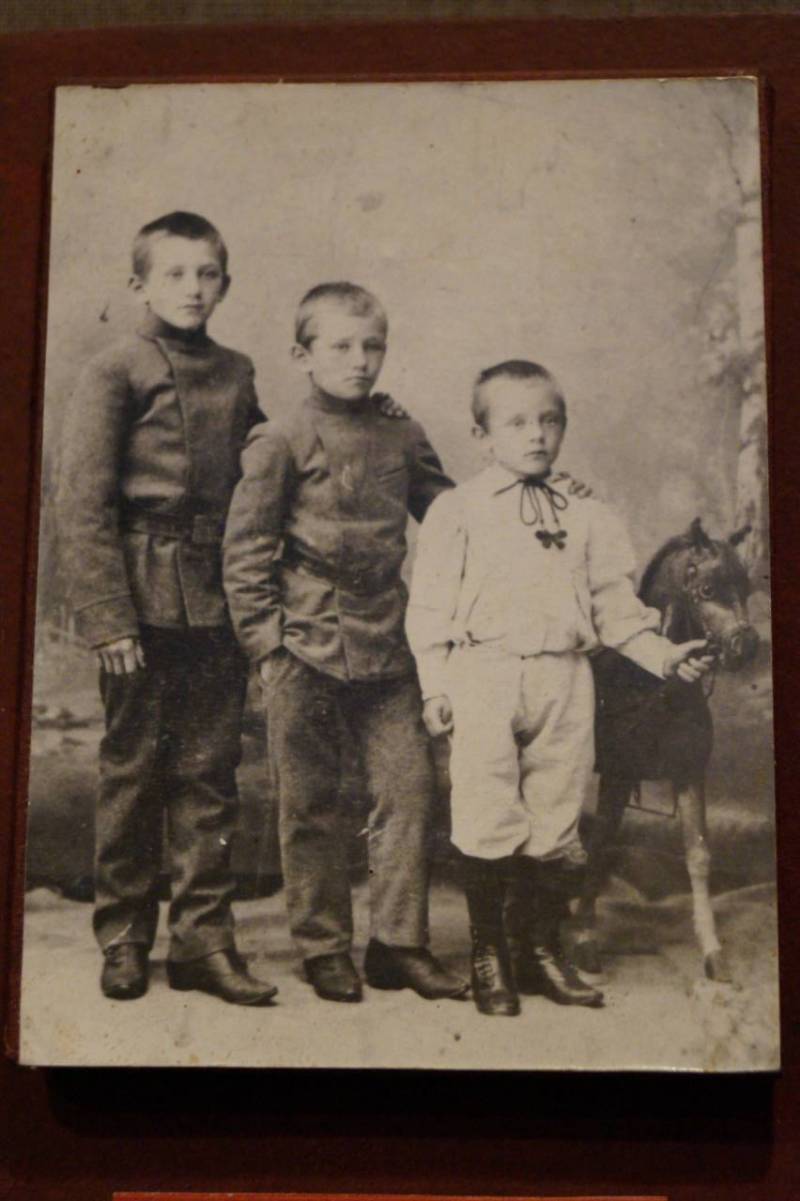Brothers Konstantinovs. They created the "Chronicles" and "Convas"
Three brothers
Konstantinovs were born in the village of Gagarino, which then belonged to the Zadonsk district of the Voronezh province. Soon their family decided to look for happiness in a “large” city and settled in Lebedyan. But ... trouble happened - father died. And the mother was left with three boys in her arms. However, after a while she again married a native swan by the name of Igumnov. So the brothers Konstantinov also appeared sister - Mary. Their childhood was spent in Lebedyan on Dvoryanskaya Street (now Sovetskaya).
The peaceful life of the Konstantinov-Igumnovs was interrupted by the First World War. Artem, as the eldest of the brothers, went to the front. Basil and Nikolai stayed at home due to their age. And soon came the terrible news - Artem died. True, there is another version. So, some local historians believe that Artem died later. Not during the First World War, and already in the Civil. The eldest of the Konstantinovs fought on the side of the Reds and was killed by a certain White Guard. Of course, for the whole family it became a serious test. But ... life for the rest has not stopped. Moreover, Vasily and Nikolay were lucky. They managed to survive the terrible times of the Civil War, and found their true vocation. The brothers devoted their lives to the development of domestic cinema.
Operator's best friend
When the situation in the country calmed down a bit, the brothers' roads parted. Vasily Konstantinov moved from Lebedyan to Moscow, the capital of the young communist state. The guy, who at the time was a little over twenty, managed to quickly find a job he liked - he became an operator at the Moscow newsreel studio. But after working for several years, Vasily suddenly realized that as a designer and inventor he would bring the film industry much more value. And here he was lucky. It must be said that in those days foreign equipment was used for filming, which, by virtue of its limited capabilities, caused outrage among documentary operators. The fact is that all these devices were tripod. And this created a number of problems. Of course, there were operators and hand-held cameras at their disposal, but they contained a small supply of film. Accordingly, they often had to recharge. And just in the 30-ies, the Soviet cinema was tasked to create its own technique for domestic documentary filmmakers.
Therefore, in 1932, Vasily began working at filmmakers at the Soyuzkinohroniki studio. It was here that Konstantinov managed to reach his full potential for one hundred percent.

Soon the “village boy” assembled the camera, which was destined to become a legend. It is about the "Convas-1". The name of the camera appeared by chance, the inventor simply joined the first three letters of his last name and first name. True, she had another name - the DAC.
The device was so successful, compared to foreign competitors, that it was immediately approved for mass production. Operators appreciated the creation of Konstantinov, so the “Convas” quickly became a truly popular camera. It was used in all corners of the Soviet Union. Love for the camera confirms the fact that its name has become a household name. About the device for filming said the following: "Conas" - he and in Africa "Conas". Charged "Konas" with a kodak, set the zoom - and no problems.
The brainchild of Konstantinov allowed the operator to quickly change the shooting point, if the situation required it. Mobility has been achieved through lightness, a mirror obturator, as well as easily replaceable cassettes and a lens. In addition, the camera was able to build the composition of the frame, make the image scaling and follow the moving object. Operators of the time were often called “Konvas” the peace-loving analog of the Kalashnikov assault rifle. Although the latter only appeared in the 1947 year, they had a lot in common: functionality, simplicity of design and reliability.
Conquest of space and cinema
The first Soviet cosmonauts, going on a flight, took the Convas with them. And those shots taken in space, saw the whole world. The pioneer in the "space shooting" can be called German Titov. With him, and began a new era of cinema. The development of Konstantinov the lonely showed well his abilities both in the “weightless pool” and in the aircraft cabin. Thanks to the camera, people of various professions were able to film documentation, capturing their experiences and experiments on tape. Actually, it was “Konvas” that was created and the cosmonian. Simply put, the cycle of filming the planet from space.
In earthly affairs, Konstantinov's camera also managed to “make some noise” notably. Due to its mobility and versatility, Convas allowed operators to revolutionize the shooting process. Now, in place of the combined shooting, came real, made in difficult conditions. Suffice it to recall at least the film "The Cranes Are Flying." Cameraman Sergey Urusevsky used mobile “Konvas”, not a camera on a tripod, to capture the most dramatic and emotional scenes of the film. For example, at the station. Veronica knows that Boris died. But still persistently sneaks through an avalanche of people giving away bouquets. The operator during the shooting relentlessly followed on Samoilova, which only increased the emotional effect of the scene.
Urusevsky spoke about the camera this way: “A hand-held camera, due to its technical capabilities, sometimes suggests ways to solve a particular artistic task, while it’s very important that such a camera is not at a“ dead ”point (tripod, cart, crane), but in the hands of a living human operator. And if the operator is captured by the action he is shooting, then the mood will be transmitted to the viewer, because the camera - this is the number one viewer - is in the hands of the operator in the direct and figurative sense. ”
By the way, the Moscow Olympics, held in 1980 year, also almost all of the Soviet operators captured it on “Convas”. For filming, they used the model "automatic".
Faithfully, “Convas” (like many of its upgrades) served until the middle of the 80 of the last century. Then he was forced out by other cameras, most often of foreign manufacture. And "Convas", once in retirement, is still in demand - now he occupies the position of an educational chamber for students.
But Vasily Dmitrievich did not find all this. He was gone in 1952 year.
By the way, in the 2013, the series Thaw was filmed. There was a place for the "Konvas-automatic". Cameraman Khrustalev (played by actor Yevgeny Tsyganov) filmed a train for this camera, being in a hole between the rails.
Although the film shoot, at least to fight
Another Konstantinov - Nikolai - also thoroughly "inherited" in the film industry. Only his way was more ornate. After graduating from the Lebedyanskaya gymnasium, he also studied in a single labor school. After - got a job as a commandant at the local railway station. But all this was too small for Nikolai. He understood that he could achieve more. Soon the dream came true. In 1922, Nikolay became an instructor of cinematography of the Tambov branch of photo-movie management.
Three years later, he made a huge step forward along the career ladder - he received the position of full-time cameraman at the Moscow Chronicle and Documentary Studio. This work implied frequent business trips, and not only over the territory of the vast Soviet Union. Outside the country, Nikolai visited thanks to a seat on board the steamer Dekabrist. That journey lasted about one and a half years. During this long time, Konstantinov managed to capture the Mediterranean Sea through his camera lens, as well as two oceans - the Pacific and the Indian. Accordingly, on their return, the cinemas of the Soviet Union launched the rental of three Konstantinovsky “documentaries”: “Around Asia”, “Kamchatka” and “In India”. For his work, enthusiastically accepted by critics and spectators, Nikolai won several state awards.
But in history Soviet cinema Nikolai Dmitrievich entered not only as a venerable cameraman. The famous camera "Chronicle" is his creation. The device was created at the beginning of the 30-s of the last century. Konstantinov took for his “base” the undercarriage at that moment in the “Pate” camera. And having gained experience, a few years later, he developed a device that could be used to carry out shooting work from an airplane. Nikolay did not trust anyone to assemble his brainchild and personally supervised this process in the workshops at the newsreel studio in the capital.
He then created another camera, the KS-4. Its production was established at the Leningrad plant shortly before the outbreak of World War II. A little later, a compact device called the Chronicle Baby was born. And when the Germans invaded the USSR - "Chronicle-Sniper". This camera Konstantinov created specifically for military reporters. Its main feature was that it was combined with a rifle. Thanks to this synthesis, front-line cameramen have ceased to be defenseless in front of German soldiers. As for the creator of the apparatus, he spent all the war years on Sakhalin, leading the film crew. And it is not known whether the creator himself had a chance to check the “sniper” in the fighting.
After the war, Nicholas returned to his small homeland. Only he settled not in Lebedyan, but in Lipetsk, where he lived until his death in the 1960 year. He worked for the Voronezh correspondent of the Rostov Documentary Film Studio. His "documentaries" have become more mundane than ever. Now he was shooting mostly stories about collective and state farms. What time has come - such was the work. The country demanded from the master films about labor records, and not about foreign miracles.
But the routine did not devour him. Nikolai created a special documentary filming machine. Outside, it was a regular van, and inside was a full-fledged film studio. This machine was convenient in that it allowed to move quickly from one place to another, and also allowed for filming from different positions. For example, from the roof. In addition, thanks to special equipment, the film was shown on site, which saved a lot of time.
And, despite the heavy workload, he often came to Lebedyan to visit his sister. And he constantly told her that the most beautiful landscapes were in Russia. Nicholas was gone in 1960 year.
* * *
The Lebedyansky museum of local lore houses a movie camera legend “Convas”. In the middle of the last century 90, it was presented by Alla Solovyova, a director who shot documentaries. In addition to the "Conas" in the museum there is an exhibition dedicated to the brothers Konstantinov. There is an interesting photo in it, in which three not childly serious boys are captured. They are beautifully dressed and look intently at the camera lens. Artemy, Vasily and Nikolai Konstantinovs then, at the very beginning of the twentieth century, did not even imagine what difficulties life was preparing for them. One remained to live a little more than ten years, and the rest - connect life with the cinema, the most modern at the time art form.
By the way, the archives of the Russian cinema fund still contain unique films shot by the Konstantinov brothers.
Here's something else interesting: in the local history museum of Lebedyan, information about the Konstantinov brothers was replenished only in the late nineties. Then the museum staff managed to get acquainted with their sister Maria Igumnova. She shared information and materials from her personal archive. So now, about the life of amazing brothers who have left a significant mark in the history of Russian cinema, any visitor to the museum can find out.



Information